This is a list of conventional orbital launch systems. This is composed of launch vehicles, and other conventional systems, used to place satellites into orbit.
YouTube Encyclopedic
-
1/1Views:10 672 170
-
Akash Missile Launch SLOW MOTION 🔥💪🏽 Destroying Target #shorts #shortsvideo #yourubeshorts
Transcription
Argentina
Australia
- AUSROCK IV – Retired
- Eris (Gilmour Space Technologies) – Under Development
Brazil
Canada
- Aurora – Under development
China




- Ceres-1
- Feng Bao 1 – Retired
- Gravity
- Hyperbola-1
- Jielong
- Kaituozhe-1 – Retired
- Kuaizhou
- Long March
- Long March 1 – Retired
- Long March 2
- Long March 2A – Retired
- Long March 2C
- Long March 2D
- Long March 2E – Retired
- Long March 2F
- Long March 3 – Retired
- Long March 4
- Long March 4A – Retired
- Long March 4B
- Long March 4C
- Long March 5
- Long March 6
- Long March 7
- Long March 8
- Long March 9 – Under Development
- Long March 10– Under Development
- Long March 11
- Tianlong-2
- Zhuque
- ZK-1A
European Union

France
- Diamant – Retired
- Zéphyr (Latitude) – Under Development
Germany
- OTRAG – Retired
- Spectrum (Isar Aerospace) – Under Development[4]
- RFA One (Rocket Factory Augsburg AG) – Under Development
- SL1 (HyImpulse) – Under Development
India




- SLV-3 – Retired
- Augmented Satellite Launch Vehicle (ASLV) – Retired
- Polar Satellite Launch Vehicle (PSLV)
- Geosychronous Satellite Launch Vehicle (GSLV)
- GSLV Mark I – Retired
- GSLV Mark II – Operational
- RLV TD: GSLV derived ascent vehicle for RLV ORE campaign.[5][6][7]
- Launch Vehicle Mark III (LVM-3)
- LVM 3 – Operational
- Human-rated LVM 3 – Under development
- LVM 3 with semi-cryogenic engine – Under development
- Small Satellite Launch Vehicle (SSLV) – Operational
- Nano Satellite Launch Vehicle (NSLV) – Under development
- Next Generation Launch Vehicle (NGLV) – Under development[8][9]
- Private agencies
- Vikram (rocket family) (Skyroot Aerospace):
- Vikram I – Under Development
- Vikram II – Proposed
- Vikram III – Proposed

- Agnibaan (AgniKul Cosmos) – Under Development
- Garuda-I (MTAR) - Under development
Iran
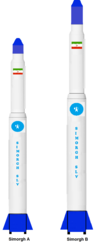
Iraq
Israel
Italy
- SISPRE C-41 – Retired
- Italian LTV SCOUT (jointly with United States of America) – Retired
- AERITALIA/SNIA/BPD ALFA – Retired
- ALENIA/SNIA-BPD SAN MARCO SCOUT (jointly with NASA) – Cancelled
- Vega (jointly with European Space Agency)
- Vega – Retired
- Vega-C – Operational
- T4i Odyssey – Under Development
Japan

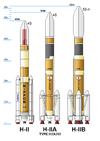

- KAIROS
- Lambda – Retired
- Mu – Retired
- N – Retired
- H-I – Retired
- H-II
- H3
- J-I – Retired
- GX – Cancelled
- Epsilon – Retired
- SS-520
- ZERO – Under Development
Malaysia
- DNLV (Independence-X Aerospace) – Under Development
New Zealand
- Electron (Rocket Lab, developed in New Zealand[16] and the United States)
- Neutron – Under Development
North Korea
- Chollima-1
- Paektusan-1 – Retired
- Unha
Taiwan
- TSLV – Under Development[17][18]
- Hapith V – Under Development[19][20]
- HTTP-3a – Under Development[21]
Philippines
- Haribon SLS-1 (OrbitX) – Under Development
Romania
- Haas – Under Development
Singapore
- Volans (Equatorial Space Systems) – Under Development
Soviet Union and successor states (Russia and Ukraine)
- Russia/USSR




- Angara
- CORONA (SSTO) – Open
- Kosmos – Retired
- Lin Industrial projects[22]
- N1 – Retired
- R-7
- Luna – Retired
- Molniya – Retired
- Polyot – Retired
- Soyuz family
- Sputnik – Retired
- Stalker (rocket)[27]
- Voskhod – Retired
- Vostok – Retired
- R-29
- Rus-M – Canceled
- Start-1
- Universal Rocket
- Energia – Retired
- Ukraine
South Africa
South Korea
- HANBIT family (INNOSPACE) – Under Development[30]
- HANBIT-Nano
- HANBIT-Micro
- HANBIT-Mini
- Blue Whale 1 (Perigee Aerospace) – Under Development
- Naro family
- KSLV-1 (Naro) – Retired[31][32]
- KSLV-2 (Nuri)
- Solid fueled LV family
- Solid fueled TV2
- Solid fueled LV – Under Development
Spain
- INTA Family
- INTA Capricornio – Cancelled
- INTA Programa PILUM – Under Development
- PLD Space Family
- Pangea Aerospace Family
- Pangea Aerospace Meso – Under development
- Zero 2 Infinity Family
- Zero 2 Infinity Bloostar – Under development
- Celestia Aerospace Family
- Celestia Aerospace Sagittarius – Under development
Turkey
United Kingdom
- Black Arrow – Retired
- Black Prince – Cancelled[35]
- Prime (Orbex) – Under Development[36]
- Skyrora XL (Skyrora) – Under Development[37]
- Skylon (Reaction Engines) – Under Development
United States
Active
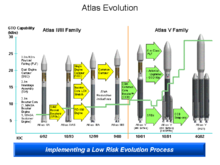
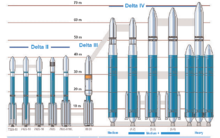
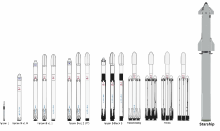
- Alpha (Firefly Aerospace)
- Antares (Northrop Grumman Innovation Systems)
- Atlas V (United Launch Alliance)
- Electron (Rocket Lab) (New Zealand/United States company)
- Minotaur (Northrop Grumman Innovation Systems)
- Pegasus (Northrop Grumman Innovation Systems)
- RS1 (ABL Space Systems)
- Space Launch System (NASA)
- SpaceX launch vehicles
- Falcon 9 Block 5 – Operational
- Falcon Heavy – Operational
- Starship – Under development
- Vulcan Centaur (United Launch Alliance)
Inactive
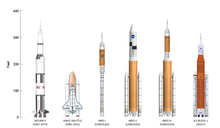
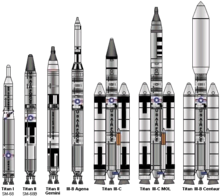
- Ares – Canceled
- Astra Space launch vehicles
- Athena – Retired
- Atlas
- Atlas B – Retired
- Atlas D – Retired
- Atlas-Able – Retired
- Atlas-Agena – Retired
- Atlas E/F – Retired
- Atlas H – Retired
- Atlas LV-3B – Retired
- Atlas SLV-3 – Retired
- Atlas-Centaur – Retired
- Conestoga – Retired
- LauncherOne
- Minotaur
- New Glenn (Blue Origin) – Under Development[38]
- OmegA – Canceled
- Orbital Accelerator (SpinLaunch) – Under Development[39]
- Phantom Express – Canceled
- Pilot – Retired
- Redstone – Retired
- Jupiter
- Relativity Space launch vehicles
- Saturn
- Scout – Retired
- Scout X-1
- Scout X-2
- Scout X-2B
- Scout X-2M
- Scout X-3
- Scout X-3M
- Scout X-4
- Scout A
- Scout A-1
- Scout B
- Scout B-1
- Scout D-1
- Scout E-1
- Scout F-1
- Scout G-1
- Space Shuttle – Retired
- SpaceX launch vehicles
- Falcon 1 – Retired
- Falcon 1e – Canceled
- Falcon 5 – Canceled
- Falcon 9
- Falcon 9 Air – Canceled
- Falcon 9 v1.0 – Retired
- Falcon 9 v1.1 – Retired
- Falcon 9 Full Thrust – Retired
- Super Heavy (booster) – Under Development
- Thor – Retired
- Thor-Able – Retired
- Thor-Ablestar – Retired
- Thor-Agena – Retired
- Thorad-Agena – Retired
- Thor-Burner – Retired
- Thor DSV-2U – Retired
- Delta
- Titan – Retired
- Vanguard – Retired
- Vector-R – Under Development
- Vector-H – Under Development
See also
- Comparison of orbital launch systems
- Comparison of orbital launcher families
- Lists of orbital launch vehicles by payload capacity:
- Small-lift launch vehicle (up to 2,000 kg to Low Earth Orbit (LEO)
- Medium-lift launch vehicle (from 2,000 to 20,000 kg to LEO)
- Heavy-lift launch vehicle (from 20,000 to 50,000 kg to LEO)
- Super heavy-lift launch vehicle (beyond 50,000 kg to LEO)
References
- ^ "Argentina Missile Chronology" (PDF). Archived (PDF) from the original on 2016-03-04. Retrieved 2012-12-30.
- ^ "Argentina Plans First Domestic Satellite Launch". Parabolic Arc. 2011-10-09. Archived from the original on 2017-06-03. Retrieved 2013-08-02.
- ^ a b c "Nov. 26, 1965: France Begins Launch Legacy with Diamant". Space News. Retrieved 13 Aug 2022.
- ^ "German startups launch mini-rocket challenge to SpaceX and co". France 24. 2021-08-04. Retrieved 2022-05-19.
- ^ "Department of Space,Annual Report 2020-21" (PDF). 4 March 2021. p. 61. Archived from the original (PDF) on 29 December 2021.
GEV for Orbital Re-entry Experiment (ORE): Launch with 1:8 scale RLV, targeted in first quarter of 2022.
- ^ "Reusable Launch Vehicle". www.vssc.gov.in. Retrieved 2022-10-28.
- ^ "75 Major Activities of ISRO" (PDF). p. 31. Archived from the original (PDF) on 18 February 2022.
In ORE, a scaled up wing body will be taken to an orbit by an ascent vehicle derived from existing GSLV and it stays in orbit for a stipulated period, re-enter and lands on a runway autonomously. The ascent vehicle has first two stages of GSLV viz S139+4L40S & GS2 and a third stage with modified PS4 propulsion system. The winged body which is a scaled up version of the RLV in RLV-TD HEX-01 mission is the fourth stage and this is called Orbital Re-entry Vehicle (ORV). This has a deployable Landing Gear System.
- ^ "ISRO developing heavy lift launch vehicles". The Hindu. 30 May 2015. Archived from the original on 12 February 2018. Retrieved 1 June 2015.
- ^ "ISRO developing new rocket to replace PSLV". The New Indian Express. 13 October 2022. Retrieved 16 October 2022.
- ^ "Al-Abid LV". Archived from the original on 2017-01-10. Retrieved 2014-07-06.
- ^ "M-4S / Satellite Launch Vehicles". ISAS. Archived from the original on 2013-05-16. Retrieved 2013-01-07.
- ^ "M-3C / Satellite Launch Vehicles". ISAS. Archived from the original on 2013-02-18. Retrieved 2013-01-07.
- ^ "M-3H / Satellite Launch Vehicles". ISAS. Archived from the original on 2013-05-16. Retrieved 2013-01-07.
- ^ "M-3S / Satellite Launch Vehicles". ISAS. Archived from the original on 2013-05-16. Retrieved 2013-01-07.
- ^ "M-3SII / Satellite Launch Vehicles". ISAS. Archived from the original on 2012-10-18. Retrieved 2013-01-07.
- ^ "Rocket Lab Celebrates Rich Ten-Year History". Rocket Lab USA. June 30, 2016. Archived from the original on July 31, 2020. Retrieved March 29, 2019.
- ^ "TSLV". Archived from the original on 2017-03-02. Retrieved 2014-07-06.
- ^ "Launch vehicles - Taiwan (Republic of China)". Archived from the original on 2020-08-03. Retrieved 2020-05-30.
- ^ "Taiwan's TiSPACE Enters Crowded Small Satellite Launch Market with Large Ambitions - SpaceWatch.Global". 20 December 2019. Archived from the original on 2020-08-03. Retrieved 2020-05-30.
- ^ "TECHNOLOGY - TiSPACE". Archived from the original on 2021-04-09. Retrieved 2019-12-28.
- ^ "About | Arrc". Archived from the original on 2020-07-17. Retrieved 2020-05-30.
- ^ "Home". Archived from the original on 2017-06-02. Retrieved 2016-02-07.
- ^ "Adler smallsat launch vehicle". Archived from the original on 2017-07-13. Retrieved 2016-02-07.
- ^ "Aldan microsat launch vehicle". Archived from the original on 2017-07-13. Retrieved 2016-02-07.
- ^ "Aniva microsat launch vehicle". Archived from the original on 2017-07-13. Retrieved 2016-02-07.
- ^ "Taymyr Microsat Launch Vehicle". Archived from the original on 2017-06-14. Retrieved 2016-02-07.
- ^ "Кто зарабатывает на космосе в России и мире" [Making Money in Space: Russian and International Players] (in Russian). RBC Trends. 2021-05-17. Retrieved 2021-11-11.
- ^ Golubeva, Alena (9 April 2021). "Максим Дегтярев: "Спрос на выведение грузов на орбиту будет расти"" [Maxim Degtyarev: "The demand for placing cargo into orbit will grow"]. GMK Center (in Russian). Retrieved 11 May 2021.
- ^ "CHEETAH-1". b14643.de. Archived from the original on 2012-12-27. Retrieved 2013-02-02.
- ^ "5t급 국산 우주 로켓엔진 불 뿜었다…하이브리드 로켓엔진 개발하는 이노스페이스는 어떤 기업인가" [A 5t-class domestic space rocket ignited it's engine... Who is Innospace, a company behind the development of a hybrid rocket engine?] (in Korean). 27 January 2021. Retrieved 27 July 2021.
- ^ Tong-hyung, Kim (2008-07-23). "Russia Dragging Feet Over Korean Rocket Launch". Korea Times. Archived from the original on 2011-05-22. Retrieved 2008-12-29.
- ^ "South Korea's First Rocket Launch Might Be Put Off". Space-Travel.com. 2008-07-24. Archived from the original on 2009-01-29. Retrieved 2008-12-29.
- ^ Limón, Raúl (2023-10-06). "El 'Miura 1' despega con éxito desde Huelva y mete a España en el exclusivo club de países con acceso al espacio". El País (in Spanish). Retrieved 2023-10-18.
- ^ "UFS". Archived from the original on 2017-12-05. Retrieved 2014-07-06.
- ^ "Black Prince (project)". b14643.de. Archived from the original on 2017-03-10. Retrieved 2019-11-11.
- ^ "Startup Company Orbex Reveals Prime Rocket That Could Launch From The U.K. In 2021". Forbes. 2019-02-07. Archived from the original on 2019-11-04. Retrieved 2019-09-12.
- ^ "Skyrora Reveals Launch Of Second Private Rocket From U.K. Soil". Forbes. 2019-08-08. Archived from the original on 2019-09-04. Retrieved 2019-09-12.
- ^ "Jeff Bezos is not screwing around with his plans to colonize space". ars Technica. 2016-09-12. Archived from the original on 2017-12-03. Retrieved 2019-09-12.
- ^ Wattles, Jackie (2022-05-11). "Watch a space startup spin a projectile into the sky at more than 1,000 miles per hour | CNN Business". CNN. Retrieved 2022-08-13.
- ^ Mars, Kelli (2021-10-26). "60 Years Ago: First Launch of a Saturn Rocket". NASA. Retrieved 2022-08-13.
- ^ Mohon, Lee (2021-03-31). "SA-4 Launches – March 28, 1963". NASA. Retrieved 2022-08-13.
- ^ Smith, Yvette (2020-02-26). "First Flight of Saturn IB". NASA. Retrieved 2022-08-13.
- ^ Mohon, Lee (2021-07-14). "Final Launch of the Saturn IB – July 15, 1975". NASA. Retrieved 2022-08-13.
- ^ "What Was the Saturn V?". NASA Solar System Exploration. Retrieved 2022-08-13.
